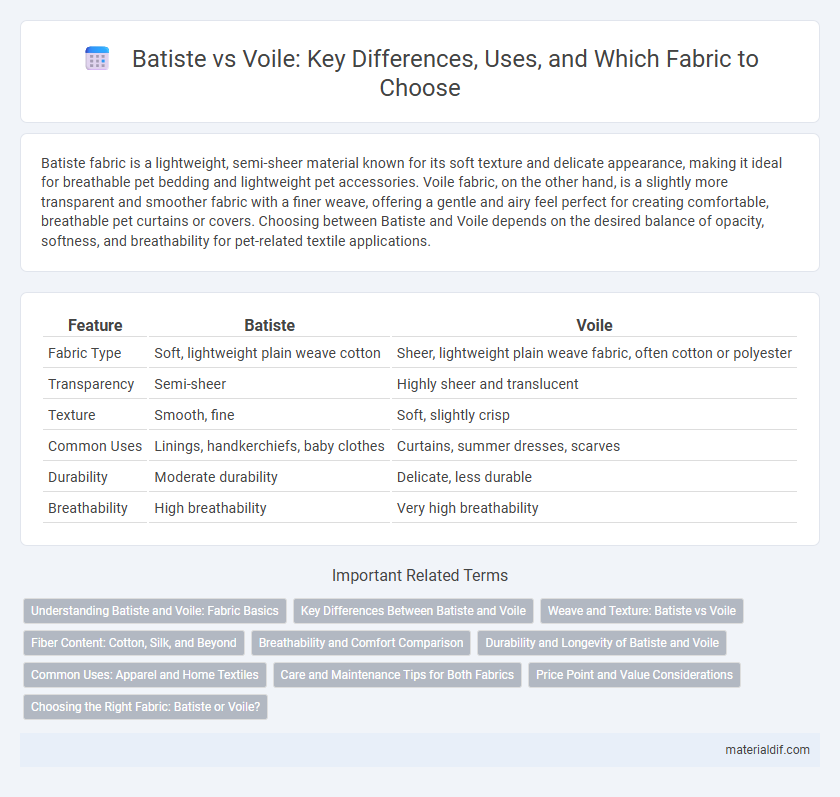Batiste fabric is a lightweight, semi-sheer material known for its soft texture and delicate appearance, making it ideal for breathable pet bedding and lightweight pet accessories. Voile fabric, on the other hand, is a slightly more transparent and smoother fabric with a finer weave, offering a gentle and airy feel perfect for creating comfortable, breathable pet curtains or covers. Choosing between Batiste and Voile depends on the desired balance of opacity, softness, and breathability for pet-related textile applications.
Table of Comparison
| Feature | Batiste | Voile |
|---|---|---|
| Fabric Type | Soft, lightweight plain weave cotton | Sheer, lightweight plain weave fabric, often cotton or polyester |
| Transparency | Semi-sheer | Highly sheer and translucent |
| Texture | Smooth, fine | Soft, slightly crisp |
| Common Uses | Linings, handkerchiefs, baby clothes | Curtains, summer dresses, scarves |
| Durability | Moderate durability | Delicate, less durable |
| Breathability | High breathability | Very high breathability |
Understanding Batiste and Voile: Fabric Basics
Batiste is a lightweight, semi-sheer fabric made from fine cotton or cotton blends, known for its soft texture and subtle translucency, making it ideal for delicate garments and linings. Voile, also lightweight and semi-sheer, is traditionally crafted from cotton or cotton blends with a slightly crisper feel and a smoother finish, often used in curtains, summer dresses, and blouses. Both fabrics offer breathability and softness but differ in weave tightness, texture, and typical applications, with batiste leaning towards a gentler drape and voile providing a more structured silhouette.
Key Differences Between Batiste and Voile
Batiste is a lightweight, semi-sheer fabric made from fine cotton or cotton blends, known for its crisp texture and soft drape, often used in delicate garments and handkerchiefs. Voile is a semi-transparent, plain weave fabric typically crafted from cotton or polyester, characterized by its smooth, slightly stiffer feel and excellent breathability, making it ideal for curtains and summer clothing. The key differences between Batiste and Voile lie in their texture, weave tightness, and typical applications, with Batiste being finer and softer, while Voile offers more structure and durability.
Weave and Texture: Batiste vs Voile
Batiste features a fine, plain weave that creates a lightweight, crisp texture ideal for delicate garments and linings. Voile has a similar plain weave but is more tightly woven, resulting in a softer, sheerer, and slightly more textured fabric commonly used in drapery and summer apparel. Both fabrics share breathability and translucency, but batiste offers a crisper hand while voile provides a smoother, more flowing drape.
Fiber Content: Cotton, Silk, and Beyond
Batiste fabric typically features a blend of fine cotton fibers creating a lightweight, crisp texture ideal for summer apparel and delicate linings. Voile incorporates a mix of cotton, silk, or synthetic fibers, resulting in a semi-sheer, soft hand that enhances drape and breathability in curtains and lightweight garments. Both fabrics vary in fiber content to balance durability, feel, and translucency, with batiste favoring predominantly cotton and voile embracing blends for enhanced elegance.
Breathability and Comfort Comparison
Batiste fabric offers moderate breathability and a soft texture, making it suitable for lightweight garments with a comfortable feel. Voile, composed of a finer, more tightly woven cotton or cotton blend, provides superior breathability and a silkier surface while remaining crisp and lightweight. Compared to Batiste, Voile allows better air circulation and moisture absorption, enhancing comfort in warm climates.
Durability and Longevity of Batiste and Voile
Batiste fabric, known for its finely woven, lightweight cotton or cotton blends, offers moderate durability suited for delicate apparel but may succumb to wear and tear with frequent use. Voile, made from tightly woven cotton or cotton blends as well, provides higher tensile strength and resistance to abrasion, resulting in superior longevity compared to Batiste. While both fabrics are breathable and soft, Voile's denser weave enhances durability, making it preferable for garments subjected to more rigorous wear.
Common Uses: Apparel and Home Textiles
Batiste fabric, known for its lightweight and semi-sheer texture, is commonly used in apparel such as summer dresses, blouses, and baby clothes due to its soft feel and breathability. Voile, also lightweight and semi-transparent but with a slightly crisper hand, is frequently employed in home textiles including curtains, drapes, and sheer window treatments to allow natural light while maintaining privacy. Both fabrics share versatility in warm-weather clothing and decorative home applications but differ in tactile qualities and slight variations in transparency.
Care and Maintenance Tips for Both Fabrics
Batiste fabric requires gentle washing in cold water and air drying to maintain its lightweight and delicate texture, avoiding harsh detergents or bleach. Voile fabric, made from cotton or cotton blends, benefits from hand washing or using a gentle cycle with mild detergent, and should be ironed while slightly damp to prevent stiffness and preserve its semi-sheer quality. Both fabrics need careful handling to avoid damage and maintain their softness and translucency over time.
Price Point and Value Considerations
Batiste fabric typically offers a lower price point compared to Voile, making it a cost-effective option for budget-conscious projects. Voile, known for its lightweight and sheer qualities, commands a higher price but delivers superior breathability and drape. The choice between Batiste and Voile depends on balancing affordability with the desired fabric performance and aesthetic value.
Choosing the Right Fabric: Batiste or Voile?
Batiste, a fine, lightweight cotton fabric, offers a smooth texture with a slightly crisp feel, making it ideal for delicate garments and summer wear. Voile, similarly lightweight but with a semi-sheer appearance and a soft drape, excels in creating flowy dresses and curtains that require breathable comfort. Selecting between batiste and voile depends on desired opacity, drape, and usage--batiste suits structured, breathable designs, while voile enhances airy, translucent aesthetics.
Batiste vs Voile Infographic

 materialdif.com
materialdif.com